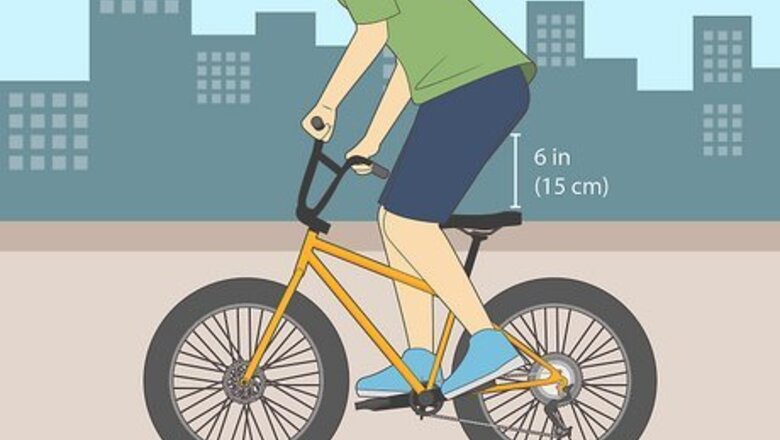
views
Mastering the Bunny Hop

Ride standing up and bend your elbows a little bit. You cannot bunny hop if your butt is resting on the saddle, so use the pedals to stand up on the bike. You don’t need to stand straight up, though; so long as there is a 6 in (15 cm) gap between the saddle and your backside, you’re good. Keep your knees slightly bent and bend your elbows in a little bit. Your speed doesn’t matter here, but it will be easier to practice if you’re moving slowly, but steadily across a flat surface. The bunny hop is essentially the ollie of BMX riding. It’s where you lift the bike up into the air so that both wheels are off the ground. Keep in mind, you are not bunny hopping if you get airborne off of a ramp—that’s a flyout. The bunny hop is the foundation of many BMX tricks. If you can bunny hop effectively, you’ll be able to pull off a wide variety of tricks in the future.
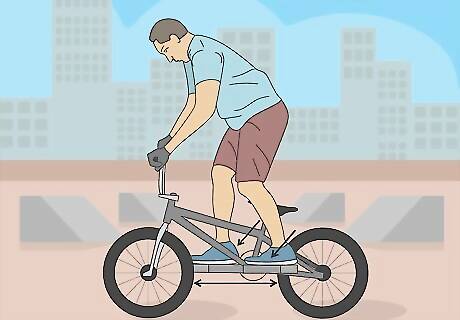
Press your feet firmly against the crank legs on your pedals. If your pedals are parallel to one another, tuck the sides of your shoes against the crank arms that hold the pedals in place and brace the bike. If your pedals are not parallel to one another, press the crank arm on the lowest pedal inwards with your ankle to keep it from spinning. The goal here is twofold. First, you need to keep your feet on the pedals. If you go airborne and your feet are off of the pedals, it will be exceptionally difficult to land safely. Second, you’re going to use your lower body to pull the back wheel off of the ground. If you don’t brace the pedals with your feet, you’ll be relying entirely on your upper body to raise the back wheel, which will be difficult. There are a variety of ways to do this. Some riders like to tuck the fronts of their shoes under the crank arms and hold the pedals in place. If you find another way to brace the pedals and keep your feet secured, it should be fine.
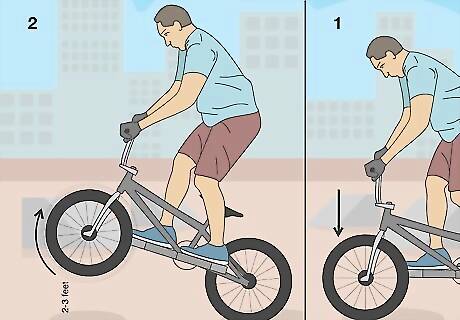
Push your front tire down before lifting it up in the air. Keep your feet tucked against the crank legs and push down into the ground with your handlebars to compress the front wheel a little bit. Then, lift your arms up immediately while pulling the handlebar up to raise the front wheel 1–2 feet (0.30–0.61 m) into the air. Resist every urge you have to lean backward while doing this. You don’t want to fall on to your back as you’re lifting up!
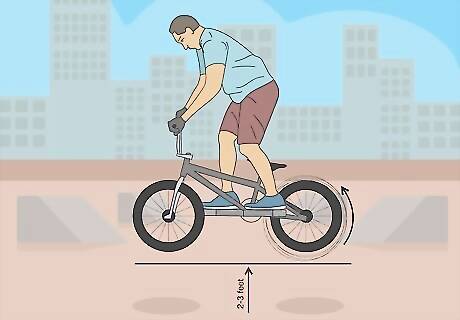
Lift the back tire up with your feet to catch some air. As the front tire is reaching its maximum height, push the front tire forward. At the same exact time, use your lower body to tug the back half of the bike up. As you get 2–3 feet (0.61–0.91 m) off of the ground, level your front tire out so that you’re landing with your wheels perfectly aligned. This can take a fair bit of practice. Try not to get frustrated if you’re only getting 6–12 inches (15–30 cm) off of the ground at first. It’s better if you just work on getting the mechanics down first before you start trying to get crazy air. Keep your butt off of the seat while doing this.

Land on your front tire first and keep your front tire pointing forward. If you land on both wheels at the same time, your bike will hit the ground hard and it’ll be hard to maintain control. Try to push the front wheel down first so that you have an easier time stabilizing the bike as you land. Keep your butt off of the seat as you land to avoid slamming your tailbone into the saddle. Keep your tires lined up so that you don’t lose control of the bike and keep pedaling. Once you get good at bunny hopping, work on getting more and more air from a flat position. The more air you can get from a bunny hop, the more time you’ll give yourself to pull off cool tricks in the air as you get better at BMX riding.
Pulling off a Manual
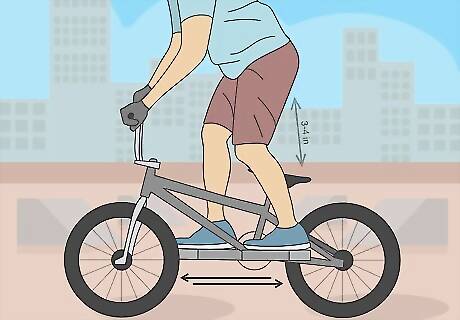
Keep your pedals at the same height and raise up off of your seat. Pedal 2-3 times slowly to get up to a low speed. Then, turn your pedals so that they sit parallel to one another at the same height off of the ground. Lift your butt roughly 3–6 inches (7.6–15.2 cm) off of your seat. A manual is basically a slow wheelie. It’s a key maneuver if you’re learning BMX tricks since you’ll often land on a manual out of a flyout or bunny hop to put a spin on another trick.
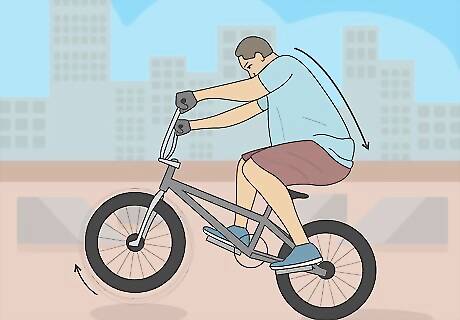
Shift your weight back and lift the front wheel off of the ground. Straighten out your arms a little bit and scoot your butt back. Lean back slowly until your wheel gently raises off of the ground. Be sure to scoot back slowly so that you don’t immediately pop up with a lot of speed. If you do, you may lose control of your bike.
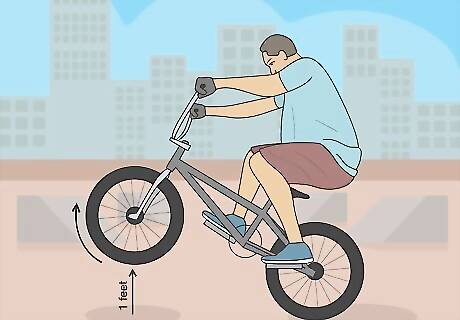
Hold the front tire roughly 1 ft (0.30 m) off of the ground. Once you’ve leaned back far enough to raise the front tire off of the ground, hold your position. Use your arms to pull the handlebars up so that your tire sits 1–1.5 feet (0.30–0.46 m) off of the ground. Maintain your balance to keep the tire up in the air. A manual is basically a slow version of a wheelie. You can turn this trick into a wheelie just by pedaling once your front tire is off of the ground. Manuals, by definition, do not involve pedaling.
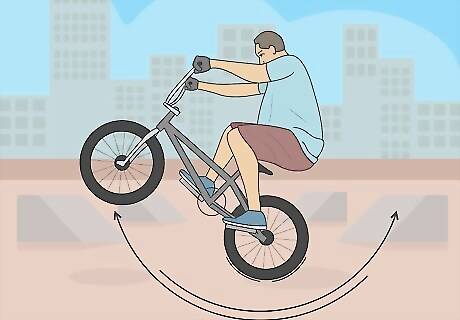
Balance your weight so that you cruise on your back wheel. With your front wheel up, lean forward or backward to continue shifting your weight so that you’re balanced on your back wheel. If you start falling forward, shift your weight back a little bit. If you start falling back, move forward a little bit. Hold it as long as you can or until you’re ready to continue riding. Once you get good at this, practice turning while you’re on your back wheel and holding the manual for as long as you can. You can even try holding the manual while you aren’t moving!
Turning with a Fakie
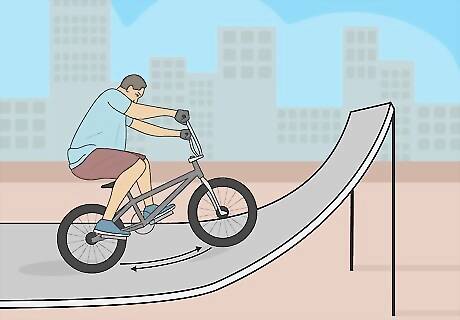
Practice the fakie at a low speed on a sloped surface or ramp. A fakie is an essential maneuver in BMX; since you can’t come out of a ramp facing the right direction if you don’t perform a 180 on the ramp, the fakie is the best way to turn around. This trick can be dangerous if you’re going too fast, so practice slowly on a small ramp or slope at the skate park. You can’t perform a fakie on a flat surface unless you hit an object with your front tire, pop up, and let your momentum drive you backward. This is a trick known as the endo, but it’s a more advanced maneuver. Unless you’ve been riding a BMX bike for years, it’s not safe to go flying off of any ramps. However, if you learn how to fakie, you can work the ramps into your riding without worrying about getting airborne.
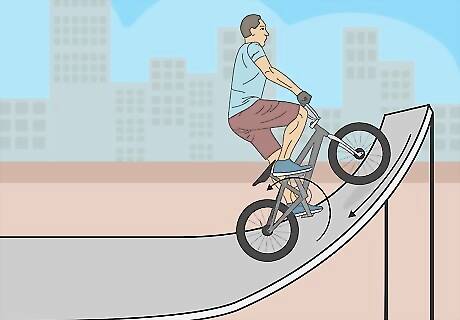
Ride halfway up a ramp and pedal backward once you stop going up. Slowly pedal toward a ramp or slope. Let your bike slowly travel up the slope. Once your bike starts sliding back down, pedal 1-2 times backward. This will give you enough momentum backward to keep yourself from falling. It will also keep your feet from fighting against the pedals as they move in the opposite direction. When a BMX bike moves backward, the pedals move backward. If you don’t pedal backward once your bike has reached the highest point on the ramp, you’re going to fall off.
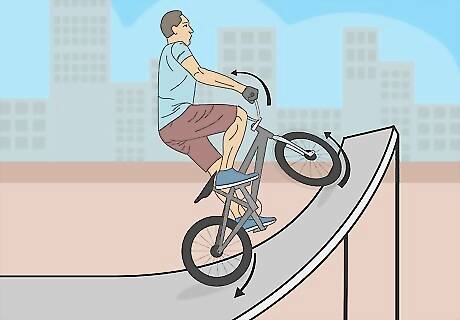
Turn the handlebars away from the direction you want to rotate. The direction you move the handlebars is opposite to the direction your bike will turn as you’re moving backward. In other words, if you want to turn to your left, move the handlebars to the right. If you want to turn to your right, move the handlebars to the left. Do this very slowly. If you turn the handlebars too abruptly, or too far, you’ll end up falling hard.
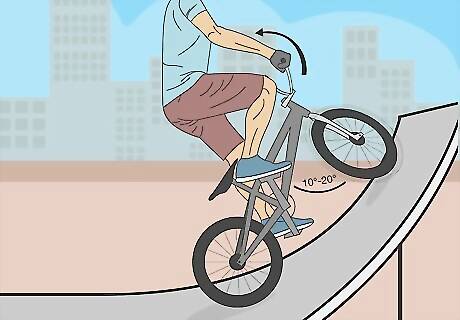
Keep the tire pointed at a 10- to 20-degree angle as you spin. Continue slowly turning the handles until the front tire is tilted at a 10- to 20-degree angle to the frame of your bike. Then, hold the handlebars in this position and let your bike continue to turn. You have to put a little trust in your riding skills here. It can be difficult to let yourself travel backward without looking.
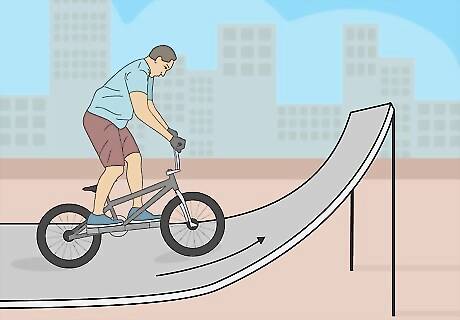
Level out as you finish spinning and start pedaling forward. Wait until you’ve spun around 180-degrees to face behind you. Then, one you’re facing the direction you want to go, straighten out your handlebar out and start pedaling forward. You have successfully pulled off a fakie! If the bike has slowed down too much by the end of the 180-degree turn, you may need to do a quick little bunny hop to reorient your front tire before pedaling forward.
Performing a Barspin
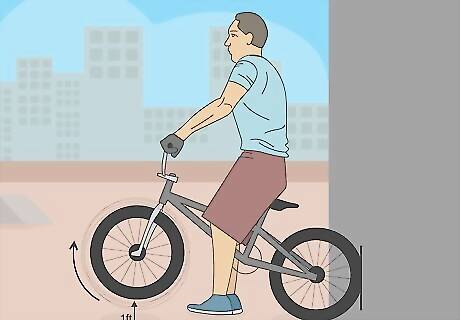
Practice the barspin with your back wheel propped against a wall. The barspin is a tough maneuver that relies on some delicate hand eye-coordination. It’s also pretty dangerous to attempt this one without getting the hand movements down first. To practice, sit on your bike with the back tire propped against a wall. Stand on the ground next to each pedal and raise your front tire up 1 ft (0.30 m) off of the ground so it can spin freely in the air. You can do this while riding once you get a hang of the hand movements, but this trick involves spinning your front tire 360 degrees while you’re in the air. If you don’t practice spinning the handlebar first, you may crash in a pretty nasty fashion.
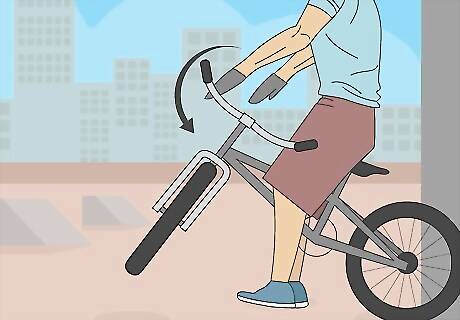
Throw the handlebar with your nondominant hand toward your body. Hold the handlebars loosely on each side. To initiate the barspin, use your nondominant hand to throw that side of the handlebar toward your body. Use a firm amount of pressure and don’t let your dominant hand catch on the other side to let the handlebar spin freely.
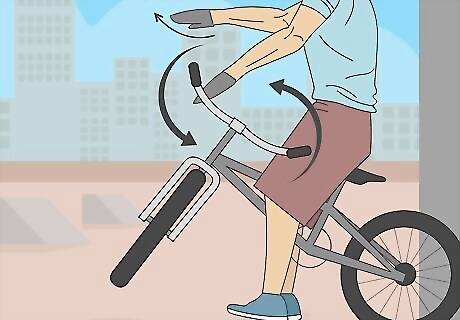
Keep your dominant hand out of the way as the handlebar spins. Let the handlebar you threw with your nondominant hand spin in front of your belly. As it passes your belly button, keep your dominant hand out of the way and let the handlebars rotate. Once the handlebar you threw passes your dominant hand, move your dominant hand down toward your belly to prepare to catch the handlebar. When you watch a pro rider pull a barspin off, it looks like they’re spinning the handlebar and catching both grips at the same time. This isn’t actually what’s happening; good riders actually catch the handlebar with their dominant hand after it has rotated roughly 135-degrees.

Catch the handlebar with your dominant hand just as it passes your belly. As your dominant hand’s handlebar grip passes the location your nondominant hand usually rests, open your dominant palm in front of you. As it hits your hand, slowly guide the handlebar to its original position. Grip it firmly once your tire is pointing forward and put your nondominant hand on the opposite side of the handlebar. Catching the handlebar is kind of like how you’d try to catch an egg if someone lobbed it to you. You kind of follow the trajectory as you’re catching it to slow it down a little and gain control. Practice doing this 20-30 times to really get used to the motion. This entire motion must be completed in under 1-2 seconds while you’re riding, so you really need to convert it to muscle memory.

Put it all together during a bunny hop or flyout. Once you’ve mastered the movement with the handlebars, try to add the barspin to bunny hops or flyouts while you’re riding. Always initiate the barspin as early as soon as you get in the air to give yourself enough time to pull it off. The barspin is really the bread and butter for most BMX riders since it’s one of the few things you can do on a bike while you’re in the air. A flyout is when you get airborne off of a small ramp or platform. You can add a barspin to any move that involves getting some air.




















Comments
0 comment